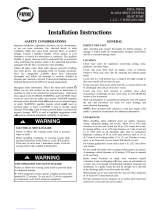
Installation Instructions
SAFETY CONSIDERATIONS
Improper installation, acljustment, alteration, service, maintenance,
or use can cause explosion, fire, electrical shock, or other
conditions which may cause death, personal iniury, or property
damage. Consult a qualified installer, service agency, or your
distributor or branch for information or assistance. The qualified
installer or agency must use factory-authorized kits or accessories
when modifying this product. Refer to the individual instructions
packaged with the kits or accessories when installing.
Follow all safety codes. Wear safety glasses, protective clothing,
and work gloves. Use quenching cloth for brazing operations.
Have fire extinguisher available. Read these instructions
thoroughly and follow all warnings or cautions included in
literature and attached to the unit. Consult local building codes and
current editions of the National Electrical Code ( NEC ) NFPA 70.
In Canada, refer to current editions of the Canadian electrical code
CSA 22.1.
Recognize safety information. This is the safety-alert symbol _X
When you see this symbol on the unit and in instructions or
manuals, be alert to the potential for personal injury. Understand
these signal words; DANGER, WARNING, and CAUTION.
These words are used with the safety-alert symbol. DANGER
identifies the most serious hazards which will result in severe
personal injury or death. WARNING signifies hazards which could
result in personal injury or death. CAUTION is used to identify
unsafe practices which would result in minor personal injury or
product and property damage. NOTE is used to highlight
suggestions which will result in enhanced installation, reliability,
or operation.
ELECTRICALSHOCK HAZARD
Failure to follow this warning could result in personal injury
or death.
Before installing, modifying, or servicing system, main
electrical disconnect switch must be in the OFF position.
There may be more than 1 disconnect switch. Lock out and
tag switch with a suitable warning label.
EXPLOSION HAZARD
Failure to follow this warning could
result in death, serious personal iniury,
and/or property damage.
Never use air or gases containing
oxygen for leak testing or operating
refrigerant compressors. Pressurized
mixtures of air or gases containing
oxygen can lead to an explosion.
INSPECT NEW UNIT
After un-crating unit, inspect thoroughly for hidden damage. If
damage is found, notify the transportation company immediately
and file a concealed damage claim.
LOCATION
Check local codes for regulations concerning zoning, noise,
platforms, and other issues.
Locate unit away from fresh air intakes, vents, or bedroom
windows. Noise may carry into the openings and disturb people
inside.
Locate unit in a well drained area, or support unit high enough so
that water runoff will not enter the unit.
Locate unit away from areas where heat, lint, or exhaust fumes will
be discharged onto unit (as from dryer vents).
Locate unit away from recessed or confined areas where
recirculation of discharge air may occur (refer to CLEARANCE
REQUIREMENT section of this document).
Roof-top installation is acceptable providing the roof will support
the unit and provisions are made for water drainage and
noise/vibration dampening.
NOTE: Roof mounted units exposed to wind may require wind
baffles. Consult the manufacturer for additional information.
CLEARANCE REQUIREMENTS
When installing, allow sufficient space for airflow clearance, wiring,
refrigerant piping, and service.
Allow 24 in. (609.6 mm) clearance to service end of unit and 48 in.
(1219.2 mm) (above unit. For proper airflow, a 6-in. (152.4 mm)
clearance on 1 side of unit and 12-in. (304.8 mm) on all remaining
sides must be maintained. Maintain a distance of 24 in. (609.6 mm)
between units or 18 in. (45%2 mm) if no overhang within 12 ft. (3.66
m).
Position so water, snow, or ice from roof or eaves cannot fall directly
on unit.
NOTE: 18" (457.2 mm) clearance option described above is
approved for outdoor units with wire grille coil guard only. Units
with louver panels require 24" (609.6 mm) between units. On
rooftop applications, locate unit at least 6 in. (152.4 mm) above
roof surface.









